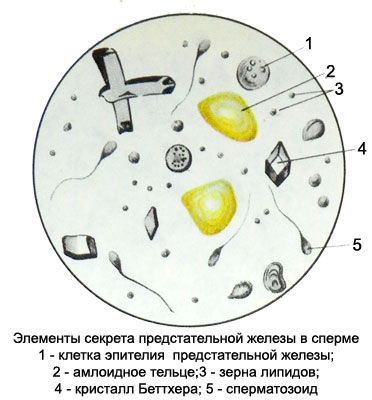Research prostatic secretions
The prostate consists of separate prostatic glands and beams myocytes - cells neischerchennoy (smooth) muscle. It is located at the exit site of the urethra from the bladder Bubble. Excretory ducts of the prostate gland and partially lined with prismatic transitional epithelium. The secret of the prostate and seminal vesicles added to ejaculate during his promotion of the urethra, giving it the look and consistency of the mucous fluid unclear.
Separate obtain secretion of the prostate is quite difficult and is usually carried out in two ways.
In the first method first take a massage with prostate secretion, and then get the secret seminal vesicle, wherein the bladder to be filled (urine is also examined under a microscope).
Second method It is in the fractional receiving ejaculate in two or three portions: in the first portion contains prostatic, the latter - the secret of the seminal vesicles.
The amount allocated secret prostate ranges from 0,1 to 4 ml, its weak acidic reaction (pH 6,0—6,4). The main components of prostatic secretions are sodium, potassium, calcium, proteins, glucose, lemon acid, acid and alkaline phosphatase, cholesterol. The prostate gland - a major source of acid phosphatase in the body. Education is its chemical characteristics of the secondary characteristic male. The content of acid phosphatase in prostatic secretions, as citric acid, It depends on the functional state of the gland. Role of prostate acid phosphatase is not completely investigated. It is believed, that it is involved in the expansion of phospholipids sperm ejaculate and provides energy.
Studies of the activity of acid phosphatase in the blood of patients with various diseases of the urinary and genital organs showed, that when expressed organic lesions of the prostate gland activity it increases 2-3 times. Many authors have noted an increase in the content of prostatic secretions of acid phosphatase in cancer of this localization. Massage prostate may also cause transient increase in acid phosphatase in the blood. The content of acid phosphatase in the blood and in the adrenogenital syndrome.
The secret of the prostate also contains a much lower concentration of alkaline phosphatase (it increases the amount of a number of diseases) and a large number of spermine, which gives a peculiar smell ejaculate. It is believed, that spermine has bacteriostatic properties and, apparently, It helps to maintain an appropriate level of concentration of hydrogen ions in the ejaculate. Spermine concentration in blood plasma ranges 254-3180 mmol / l (ug / ml), and spermidine - 30 366 mmol / l (ug / ml).
Microscopic examination of prostate secretion white blood cells are found, erythrocytes, prostate epithelial cells, amyloid corpuscles, grain lipids, Böttcher crystals.

Normally, the field of view is from the 0 to 10 leukocytes, in inflammatory processes of their number increases.
Determination of the number of white blood cells
To count the number of cells in the counting chamber Goryaeva requires two solutions:
- 1) mixture 1 g crystal violet, 0,8 g of ammonium oxalate, 30,3 ml 95 % ethyl alcohol 120 ml of double-distilled water;
- 2) mixture 0,25 Mr. safranine, 60 ml 95 % ethyl alcohol 240 ml of double-distilled water.
The working solution is prepared as follows:: 1 ml of the first solution, 32 ml - the second and 33 ml 24 % ethanol are mixed, and filtered. This solution may be stored for 3 months. Immediately before the test working solution is diluted 20 % ethyl alcohol in the ratio 1:3.
Method. The vial or glass jar making 475 l solution and Safranin 25 l prostatic secretions, mixed thoroughly and filled counting chamber. White blood cell count in 100 large squares, and the result is multiplied by 50.
The secret of the prostate (in 1 l) It is normal to 1300 leukocytes, in some individuals, their number can reach 2800.
In addition to leukocytes in prostatic secretions there are isolated erythrocytes (After the massage), their number may increase in the inflammatory process. In chronic inflammation detected as macrophages and giant multinucleated cells.
Epithelial cells in prostatic secretions
Prostate epithelial cells normally rare. When inflammation in the prostate gland (prostatitis) they have the form of round whitish cells, in a state of fatty degeneration. There epithelial cells together with leukocytes, as well as groups, often in a state of decay, or repetitive weight drops fat preserved with single cells.
Amyloid corpuscles in prostatic secretions
Amyloid corpuscles yellowish, oval, round or triangular shape, with concentric striation. The central part of them can be fine. Mostly observed in chronic inflammatory, Adenoma, prostatic hypertrophy in the elderly.
Böttcher crystals in prostatic secretions
Böttcher crystals shaped like crystals Sharko - Leiden. Lugol painted in dark blue. Their appearance in the prostatic secretions associated with prostatoreey.
Taurus Trousseau-Lallemand in prostatic secretions
Taurus Trousseau-Lallemand - form a cylindrical shape, yellowish, slightly reminiscent of waxy cylinders; their origin is not found.
Corn lipids in prostatic secretions
Corn lipids - small (the size of the platelet) Education whitish rounded shape, in which cholesterol is. A large number are found in normal prostatic secretions. If prostatitis, malignant tumors of their number sharply decreased up to complete disappearance.
The secret of the prostate can also find elements of malignancy in its decay. When prostate cancer is often observed Retention Syndrome (stagnation). In stagnant secret revealed macrophages and giant multinucleated cells.
When cyst prostate along with leukocytes and erythrocytes are detected foam cells, cholesterol crystals, Sometimes epithelial cells, lining the cyst cavity.
